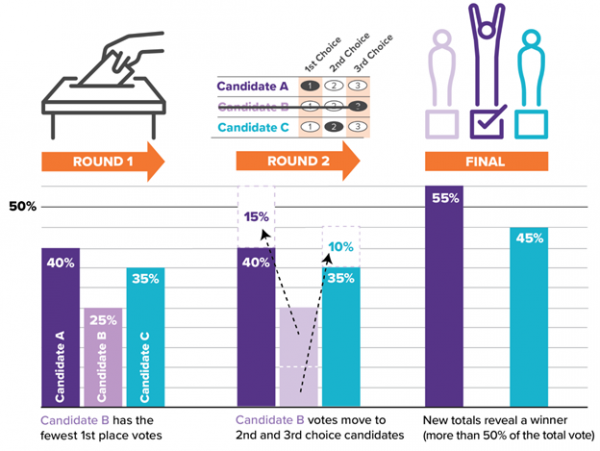Yes, as explained in detail below, because the Petaluma Charter defaults to “plurality” voting pursuant to Elections Code Section 15452, to change Council member elections to ranked choice voting would require a charter amendment.
RCV allows the electors to select in addition to their first choice, a second and third choice as backups. All first choices on the ballots are counted and if a candidate receives 50% + 1 votes than that candidate will be elected. If not, the candidate with the fewest first choices is defeated. The ballots for that candidate go to those voters’ second choices. Next, the votes will be counted again to determine if a candidate received 50% +1 votes. If a candidate has still not received a majority of the votes, this process of the defeated candidates’ votes going to the remaining candidates will repeat until there is a candidate with a majority of the votes. Below is an illustration of this process.

First, it is doubtful that just switching from an “at-large method of election” to a “ranked choice vote election” system would satisfy the California Voters Rights Act and would leave the City vulnerable to litigation. “District-based Elections” is defined in Elections Code Section 14026(b) as “a method of electing members to the governing body of a political subdivision in which the candidate must reside within an election district that is a divisible part of the political subdivision and is elected only by voters residing within that election district”. To remain in the statutory safe harbor provision and limit the City’s exposure to only $30,000 in attorney’s fees, Elections Code Section 10010(a) requires a political subdivision to “change from an at-large method of election to a district-based election.” Therefore, to limit the City’s exposure the City still needs to transition from an at-large election system to a district-based election system. However, the CVRA would likely be satisfied with a transition to district-based elections where each district has ranked choice voting.
Article III, Section 4 of the Petaluma City Charter states, “Except as herein otherwise specifically provided, all regular and special municipal elections of this city are to be held in accordance with the provisions of the Elections Code of the State of California, including all amendments thereto.” Elections Code section 15452 provides:
“The person who receives a plurality of the votes cast for any office is elected or nominated to that office in any election, except:
- An election for which different provision is made by any city or county charter.”
Accordingly, under the Petaluma City Charter, City Council members are elected by “plurality” voting as opposed to “majority” voting like runoff or RCV. In plurality voting, the candidate who receives the most votes, even if it is not a majority of the votes cast, is elected. As an example, if Candidate A receives 45% of the total votes cast, Candidate B receives 35%, and Candidate C receives 25% of the votes, in this scenario Candidate A has a plurality of the votes and would be elected under a plurality voting system.
Again, As the Petaluma Charter defaults to “plurality” voting pursuant to Elections Code Section 15452, to change Council member elections to ranked choice voting would require a charter amendment.

